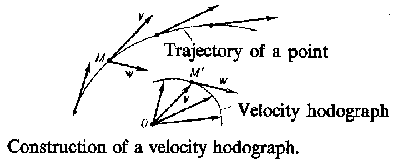Hodograph
of a vector field  along a curve
along a curve
The curve representing the ends of the variable vector  (
( is a real variable, such as time) whose origin for all
is a real variable, such as time) whose origin for all  is a given fixed point
is a given fixed point  . Trajectory of a point Velocity hodograph Construction of a velocity hodograph.
. Trajectory of a point Velocity hodograph Construction of a velocity hodograph.

Figure: h047500a
The hodograph is a visual geometrical representation of the variation (with  ) of the magnitude represented by the variable vector and of the rate of this change. Its direction is that of the tangent to the hodograph. For example, if the velocity of a moving point is represented by a variable vector
) of the magnitude represented by the variable vector and of the rate of this change. Its direction is that of the tangent to the hodograph. For example, if the velocity of a moving point is represented by a variable vector  , then by drawing the values of
, then by drawing the values of  at different moments of time from the origin
at different moments of time from the origin  , one obtains the velocity hodograph. The magnitude describing the rate of the variation of the velocity at some point
, one obtains the velocity hodograph. The magnitude describing the rate of the variation of the velocity at some point  , i.e. the acceleration
, i.e. the acceleration  at that point, has at any point of time the direction of the tangent to the velocity hodograph at the respective point.
at that point, has at any point of time the direction of the tangent to the velocity hodograph at the respective point.
Hodograph. Encyclopedia of Mathematics. URL: http://encyclopediaofmath.org/index.php?title=Hodograph&oldid=15147